[Home] [museums] [Daytrips] [Links] [E-Mail]
Prague: objects of interest
The castle
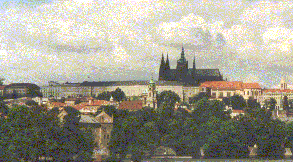
The castle is the most important object of interest of Prague.
One can easily spent a day to have a look at all the
buildings of the castle and it's garden. One can visit
four buildings;
-
The Sint-Vituscathedral: the construction started
in 1344, but had to be stopped because of war in 1431. The
construction started again in 1967 and continued ill
1925. In 1929 the church was consecrated. In the church you can have look
at, among other things, various chapels;
-
Old royal palace: imposing is the is the Vladislavzaal;
62 metres long and 16 metres wide;
-
The Mihulkatower: inside a view of the daily
life during the government of Rudolf;
-
Basilica of Sint-Joris:
Close to the Mihulkatower you can the find the entrance to
the beautiful garden.
You can reach the castle by tram 12 and 22 and subway,station
Malostranská. The writer Franz Kafka has lived for a while, and
it is here were he got his inspiration for the book “das Schlob”.
If you have enough time after you visited the castle you
can have walk along the following streets: Valdštenská ulice. At
number 8/153 you find the Furstenbergpalace and at number 10/154 the Kolowratpalace.
At Thunovská ulice 14/180 you see the Thunpalace and at the Nerudova
ulice 20/214 you find the Thun-Hohensteinpalace. At the Hradcanské
Nám?sti you can find at number 2/185 the Schwarzenbergpalace and
at number 8/67 the martinicpalace. At the Loretánske Námesti
you find:
The Loreta-sanctuary
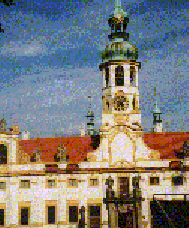 Loreta is famous because it is a place of pilgrimage and
was built during the 17th century. The name Loreta is derived from the
Italian town Loreto. According to the myth the archangel Gabriel manifested
itself to Maria in this town to announce the birth of Jesus.
Loreta is famous because it is a place of pilgrimage and
was built during the 17th century. The name Loreta is derived from the
Italian town Loreto. According to the myth the archangel Gabriel manifested
itself to Maria in this town to announce the birth of Jesus.
Loreta is also famous because of it's treasure-chamber
with hundreds of artobjects.
Staromestské Námesti (Staromestské square)

Worthwhile seeing on this square:
-
Tyn-church: built in the 14th century;
-
Golz-Kinsky-palace: built from 1755-1765;
-
St. Nicholas church: built in 1735;
-
Town hall of the old city; at the front of
the town-hall tower the famous astronomical clock, placed
there in 1490.
Karluv most (Charles bridge)
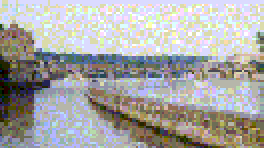 For more then 6 centuries this bridge was the only possibility
to cross the Moldau. The construction started in 1357 because it had to
replace a collapsed bridge. On the bridge you find 30 statues, 15 on each
side.
For more then 6 centuries this bridge was the only possibility
to cross the Moldau. The construction started in 1357 because it had to
replace a collapsed bridge. On the bridge you find 30 statues, 15 on each
side.
All kinds of artists (singers, painters) perform on the
bridge. If you entered the bridge on the side of the tower of the old city
and you leave the bridge on the other side, it's a good idea to take the
street at the right called “Misenská” then turn left and follow
the street called “ U luzickeho seminá” then left and follow ”Letenská”
street and right into the street called “Thomašská”. Just around
the corner the street is now called “Valdštejnská” and then
on the right hand side the:
Waldstein Palace
As far as I know this palace is not open to public, but is
has a beautiful garden, so I thought it is worthwhile mentioning.
Just around the corner the street is now called
“Valdštejnská”
If you enjoy walking follow after visiting the Waldstein
palace the “Valdštejnská” back in the direction where you came from
take the first treet to the right (Valdstejnske námesti) then left
(Snemovni), second street left, immediately first turn right allong the
Malonstranské namesti, first street right, again immediately left
(Karmelitská Ujezd). Twice, the first street to the left, go right
at the street called “Na kampa” and you end up in a beautiful park. Have
a rest (if the weather allows you to) and if look at the river you see
at the left the Charlsbridge and at your right “Legii Bridge”. If you still
in the mood to walk somewhat further, start crossing this bridge and on
the right side you will find a staircase leading to a small island, which
is quite nice.
Another nice park to visit is the stromovka park.
Petrin hill
-
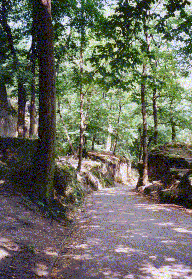
-
If your leave the Charles bridge in the way mentioned above
you also can turn left at the street called Karmelitská Uljezd and
shortly after the crossing with the street called “Hellichova” you can
take a funicular railway up to the Petrin hill. On the hill a tower which
seems to be a smaller duplicate of the Eiffeltower in Paris. The tower
is open to public. On the top you have a beautiful view over Prague. I
found my own way down, and discovered some beautiful places pathes like
on the photo.
Vysehrad
This is the second castle of Prague. If you plenty of time
while you visit Prague it worth while to spent several hours at vysehrad.
You can expect so see several statues, chapel, cemetery and you can enjoy
the view over the Moldau.
Josefov
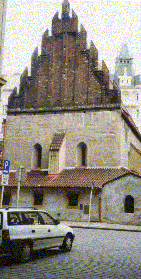
Josefov is the part of Prague were since centuries the jewish
are living.
You can visit some of the synagogues and the old cemetery.
On the photo the old-new synagogue.
In the pinkassynagogue the names of 77.297 of czech jews
who died during world war 2 are painted on the walls. I became silent when
I saw that and believe me normaly I only stop talking when I am asleep.
Zoo
Eventhough I am adult (in years at all events) I enjoyed
the zoo of Prague. Opposite to the entrance of the zoo is:
The troja castle
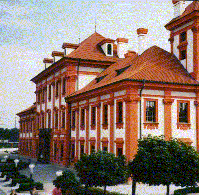
This castle is built from 1685-1697.
In this castle you have to wear oversized shuffles, to
prevent the parquet floor from damage. T
There are many (to my opinion beautiful) mural and ceiral
paintings.
Cemeteries
At the Olšanky-cemetery Jan Palach is buried. On January
16.th Jan Palach set himself on fire on the Václavské námestí
as a protest against the invasion of the Warschaupact-bodies. He died three
days later. His funeral on January 25th on the Olšanky-cemetery ended in
a huge protest against the presence of the Soviet-union. When his grave
became a symbol of resistance, the communists digged him up secretly and
re-buried him in Všetaty, his native village. In 1990 Jan Palach was digged
up once again and re-buried at the Olšanky-cemetery.
Close to the Olšanky-cemetery you can find the Zidovské
cemetery were Franz kafka is buried.



